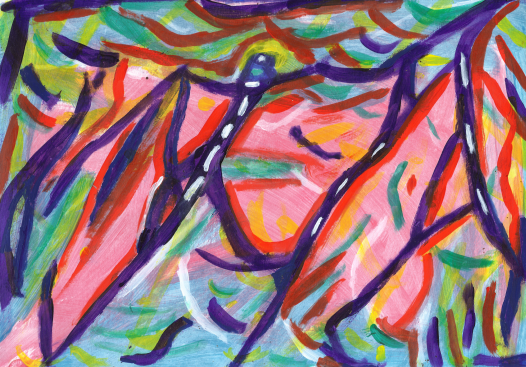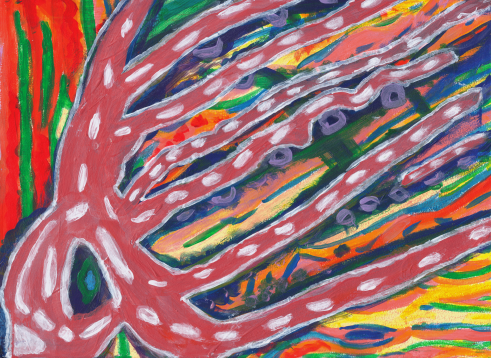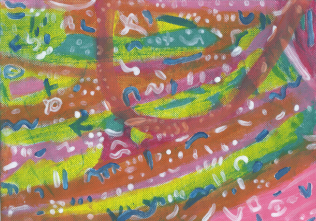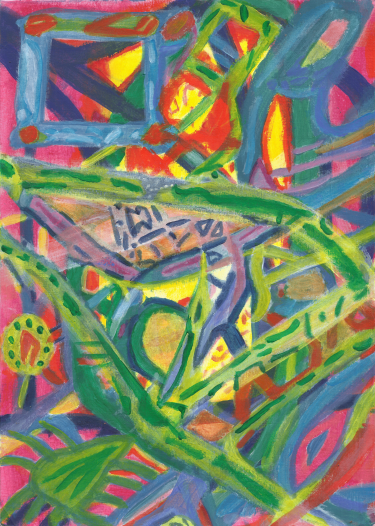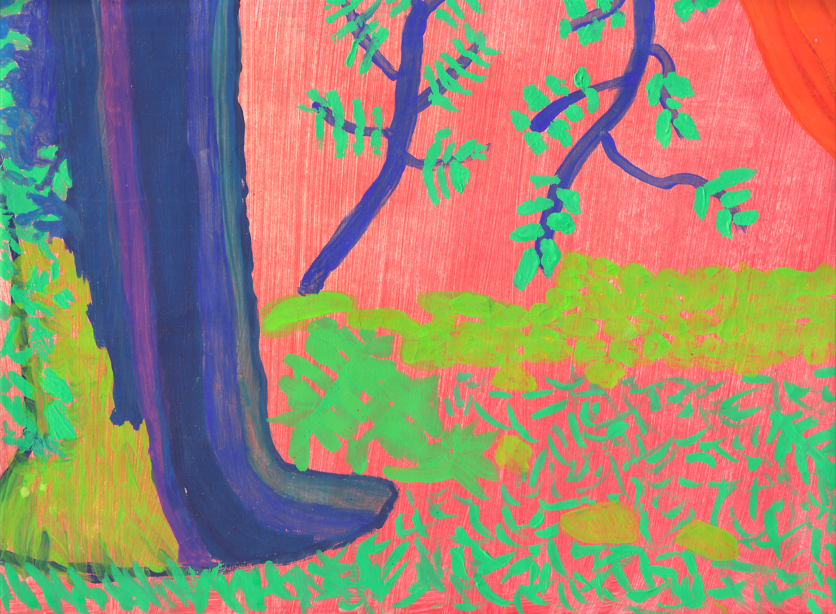Personal Blogs
This is something I have been practising during my own meditation and it has been very helpful and I quite like it.
When the mind becomes distracted in meditation and loses awareness of the meditation object, follow this simple algorithm below:
1. Notice with friendliness towards the mind, without any judgement or shame towards oneself, (always be gentle, be a friend to the mind and it will be a friend back) just become aware that the mind has wandered from the meditation object. Then...
2. Let go of whatever the distraction was, it doesn't matter what it was, the details are irrelevant, there's no need to tie up any lose ends or tidy up the thoughts. Just let go of the distraction and become aware of the body.
3. Relax any tension you feel in the body, remembering also to relax the face and head, as thoughts can bring tension to those areas. Spend some time doing this, take as long as feels natural. One is purposefully calming the body, and bringing into awareness a sense of bodily ease and pleasure.
4. Gladden the mind, like the zesty zingy feeling of a refreshing spring breeze. Kindle some joy in the mind. Smile inwardly, smile with your heart, and turn the corners of your mouth up, even if it's just a little, teeny slight barely-noticeable smile. That'll do! It doesn't matter if at first it feels fake, smiling releases endorphins and the mind will catch on and the smile will eventually become genuine. Then let that warm pleasant energy spread throughout the whole body. Saturate the entire body with it.
5. Then reflect for a moment on how the mind feels when it is lucid, serene and free from craving.
There are two sides to craving: craving for sense pleasure, and craving for circumstances to be different. They are both two sides of the same coin.
These are the four noble truths:
Knowledge of suffering (which is to be understood).
Knowledge of the cause of suffering (which is to be abandoned).
Knowledge of the end of suffering (which is to be realised).
Knowledge of the way that leads to the end of suffering (which is to be developed).
Can you see the four noble truths in your meditation practise: noticing the craving, letting go of the craving, experiencing freedom from the craving, and the cultivation of the noble eightfold path that leads to the end of craving.
6. Return to focusing on the meditation object.
7. Rinse and repeat every time the mind wanders.
Samma Samhadi (Right Concentration) can be translated as lucid serenity. Unfortunately, Right Concentration can create the wrong impression of meditation practise. Samma Samhadi is not a hard tunnel-vision focus. One is not concentrating so hard that it blocks out everything else from conscious awareness, that just creates tension in the mind and the body. No, Samma Samhadi is a still, calm, lucid, relaxed, expansive and serene awareness. Anchored in the body, so the mind does not float off like a helium balloon. One meditates with awareness of the body in the background. This is what is meant by one pointed attention, it means wholehearted attention grounded in the body, it is an embodied attention. A unification of mind, all of the mind collected and gathered together, attending to the meditation object together as one. The four jhanas which the Buddha defined as Samma Samhadi are known as the rupa jhanas because they are embodied, i.e. awareness of the body is present throughout.
Samhadi (lucid serenity) and vipassana (insight) are actually one and the same, they are not two distinct separate practises. They are part of the same meditation. They are like two wings of a bird that take you to nibanna. Nibanna in a nutshell means irreversible freedom from suffering. I.e. there's no comedown from it, the freedom is permanent. And nibanna can be experienced here and now in this very life if one practises ardently enough. Different stages of enlightenment bring progressively greater freedom from suffering.
In Buddhist practise there's nothing magical happening, although it can certainly feel like that at times, (encounters with the unconscious parts of the mind can often feel magical,) one is just simply training the mind. If one puts in the right causes and conditions, one gets the results. In the case of Buddhist training, the final result is irreversible freedom from suffering.
Right input equals right output. Bad input equals bad output.
Having a good teacher helps immensely, but the training is doable on one's own if one is determined enough, but honestly find a teacher and some good spiritual friends, it will save you a lot of time and make the practise much richer and joyful. There are many Buddhist teachers and groups available online and one does not need to travel great distances to find one anymore, one can now train virtually via the Internet for free from one's home without having to travel anywhere or go on a lengthy retreat. All my teachers and spiritual friends are online.
The noble eightfold path is the training one undertakes to become a Buddha. The Buddha famously once said: 'One who sees the dhamma sees me. And one who sees me sees the dhamma.' The dhamma is the mind of the Buddha, and one who has mastered the dhamma, becomes a Buddha.
Not a clone though, one still has whatever personality traits one had before, but now freed from greed, hatred, and delusion. A bit like how there is a recipe to bake bread, but there can be different kinds of bread, they all however follow the same basic recipe and use the same core ingredients. The loaves of bread can look different when they come out of the oven, but despite their difference in appearance, one can still see and know it is bread.
Peace and metta!
Wishing,
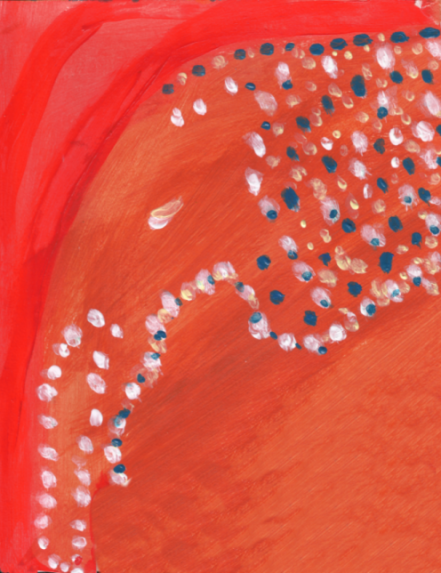
Walking inner streets
Alive with techno beats
Expanded heart and mind
Explore a deeper world within
The elements echo
An ancient feeling
A timeless
Wordless
Memory
Something altogether unworldly
A golden peace.
Light and breezy
Tranquil sound of waves
As invisible air shapes its
Sign on skin and water
Seagulls call glide
Circle high above
These worn sandy shoes
With feet bright
Like Spring.
A deep sea mining operation drills a little too deep...
Free download of a 300 dpi scan for personal non-commercial use is available at: https://thestonecub.wordpress.com/2022/04/25/kraken-wakes/
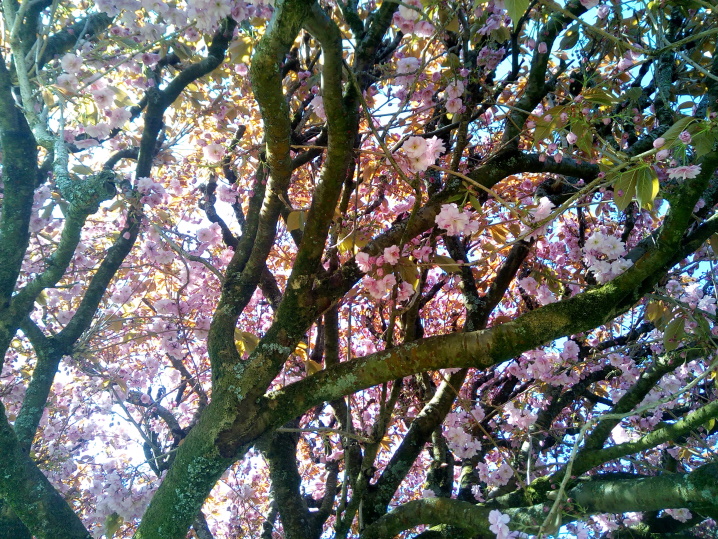
‘ I hate a song that makes you think that you’re not any good. A song that makes you think you are born to lose, bound to lose. No good to nobody. No good for nothing. Because you’re either too old, or too young, or too fat, or too slim, or too ugly, or too this or too that.
Songs that run you down.
Songs that poke fun at you on account of your bad luck, or your hard travelling.
I’m out to fight those kinds of songs to my very last breath of air and my last drop of blood.
I am out to sing songs that will prove to you that this is your world.
And yes it can hit you pretty hard and knock you down for a dozen loops; but no matter how hard it runs you down, or rolls over you. No matter what colour, what size you are, how you’re built. I’m out to sing the songs that will make you take pride in yourself, in your work.
The songs I sing are made up for the most part by all sorts of folks, just about like you. ‘
Rise up for the revolution.
A revolution of friendship and love.
Can you hear that?
‘ This grand shout of affirmation. To mark where we’ve been. To testify to what we have within us, what we can accomplish.
And yes in the end everything must finally fall to the universal fact of life. But be of good hearts. Our songs will all be silenced, but what of it? Go on singing. '
Was ruminating just now over feelings of regret and longing. These can pop up and disrupt the flow of peace at times. How to deal with those?
I have been practising telling myself each time that I can't change the past. What has happened has happened, there's no super-power I have that can turn back the clock and make me do things different. And even if I could, would I want to?
Past mistakes were done by a younger self that didn't know any better. But now you do know better, and it is because of your younger self that you know better. So stop punishing yourself, take a bow to your younger self and resolve to honour the mistake by being wiser from now on. And remembering your less-than-graceful moments can help one to be humble, which is helpful for overcoming conceit. But the guilt, longing, aversion, anxiety and remorse is not helpful, that can be let go of.
Your younger self is not who you are now. And it is who you are now that's important. Who you are now is what's generating the kamma for your future self.
Putting oneself down and feeling guilt, shame and anxiety will become a habit when repeated over a lengthy period of time, and it is a habit that is no good for the mind. It depresses it, and a depressed mind is no fun to be in at all. Our mind is our home, and so we should make it the kind of home that is warm, friendly, welcoming, wise, peaceful, and a refuge even when times are shit.
Unfortunately pain, sickness, fatigue, loss and separation is inevitable in this world. That is the kamma of having a body. Noone escapes this, not even enlightened beings. The Buddha aged, got sick, had back problems, had a toxic cousin intent on murdering him, and he died.
It is the fate of all living beings.
What is the most important thing to have with us when we die?
Our time here is short and one could die at any moment, old age is not guaranteed, people die at different ages and that's normal; across the many species of life on Earth both young and old die. Noone knows how much time they have here.
And it isn't these things that are the problem. They are inevitable, they are outside our control, that's the way it is in a changing universe of interdependence and entropy.
The problem is how we feel about these things. It is the hostility in the mind towards them that is the problem. Aversion is an unpleasant emotion, it comes with unpleasant sensations, unpleasant feelings and thoughts. It makes one's consciousness feel toxic and unhappy. To the point where one would do anything to get rid of it. And it brings us negative consequences - one's kamma, setting us up for more misery in the future. And yet we can't see that it is this hostility in the mind, this craving for things to be different that causes the suffering.
The good news is that aversion is not necessary and can be removed from the mind. And why wouldn't one want to remove it from the mind? It is not helpful, and one can live perfectly well without it.
Aversion is generated by the mind. And because it is generated by the mind, it is possible to train one's mind to let go of it, and feel the relief of a mind that is not hostile. A serene happy mind filled with unconditional love instead of fear. It is easier to feel love for others when the mind is less hostile, when you realise all beings value their lives. That all beings want to feel safe, loved, and at peace. Just like you do.
Our mind is our true home. It is what we take with us when we die.
It might take time, a lot of practise, perseverance and a huge helping of patience. But continue putting in the right causes and conditions even when it feels like a desert and a trudge, and eventually the garden will flower and fruit all by itself. But remember to be gentle with the mind, a friend to it, take regular breaks and rest from the work. Impatience and overdoing it won't make anything grow faster.
I become someone new
each and every moment.
Who am I?
What am I?
Just streams,
always changing,
rearranging.
Insubstantial.
Interdependent.
Energy.
Flows.
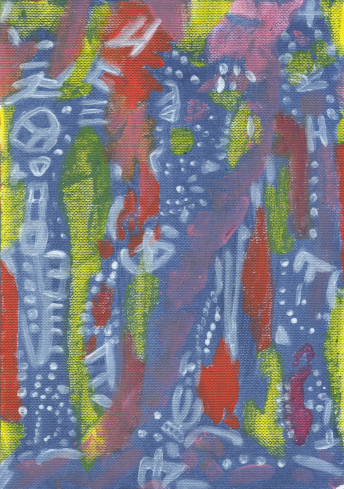
A free download of painting as 300dpi scan is available here from my website for personal, non-commercial use.
May you be filled with serenity, peace and infinite wellbeing.
To greatly weaken the mind’s tendency to aversion is wonderful. But nothing magical, it is just training the mind. If anyone with enough determination puts in the right causes and condtions, they will get the results.
I still have much work to do to go further on the path. I must now weaken sensuality, the next guardian at the gate. And there seems to be a strong resistance to do this in my mind. It is quite attached to sense pleasures. The Buddha said that sense-desire is a lesser stain on the personality than aversion. But comes with a trade-off in that it is harder to remove. And he is right, it is proving tricky to go beyond this guardian at the gate.
But I can see a strategy for overcoming sense desire. It will involve a great deal of patience and playing the long game, it will involve the four right efforts, right mindfulness, and the eighth factor of the noble path: Right Samhadi (right concentration). Right Samhadi is defined by the Buddha as the four jhanas. And jhana is described as a delicious state of consciousness by meditators who have learnt how to get into them.
Once one has learnt how to get in and out of jhana quickly, and can sustain these states of mind indefinitely, as well as come out of them at will. They discover a bliss they can generate all by themselves within, something that is described as being a greater bliss than anything external or that the world can offer. Then one can naturally let go of sense desire. A person at this stage of enlightenment who has completely cut off the two fetters of: greed(sense-desire) and aversion is known as an anagami (non-returner). They are never again born into this world. And in their next life they are reincarnated in the higher heavens, living very long lives there (aeons). They are born there because of their attachment to jhana. But this is absolutely fine, because what happens is they just carry on practising and make it to the fourth stage of enlightenment, realise nibanna and become fully liberated in the higher heavens - like celestial Buddhas (-:
There are some teachers of Buddhism who have been misguided about the jhanas, and some who even say they are not necessary. Whilst it is true that the jhanas aren’t necessary to reach the first and second stages of enlightenment (stream-enterer and once-returner), if one wants to go further, beyond the second stage of enlightenment, one needs to learn and get good at jhana (right samhadi). At least that’s my understanding, and some will disagree, but intuitively what I am thinking here feels right to me (on my journey anyway).
To learn jhana though one needs to be very determined and seclude themselves from sensuality (at least for a set time). The first verse goes: ‘Quite secluded from sense pleasures, secluded from unwholesome states of mind. One enters and abides in the first jhana. Which is accompanied by applied and sustained thought, and has the rapture and pleasure born from seclusion from the world and letting go.’
The way I practise this is when I meditate I go outside somewhere quiet away from everyone. Which secludes me from other people’s energies and also from all the technological devices in my room, and the kettle (cups of tea lol). Doing this forces me to concentrate wholeheartedly on the meditation with nothing around me to tempt or distract me. This is what it means to become quite secluded from sense pleasures.
Secluded from unwholesome states of mind, means to let go of the five hindrances (worldy-desire, aversion, stagnation (or lack of motivation), agitation, doubt); and also means to let go of all the stress of the day and problems we encounter in the world and the kamma of having a body. Put that heavy suitcase down for a moment and feel the relief. Refuse to pick up or inspect the contents of the suitcase, just leave it be. No harm will come if you let go of it for a time. We let go of our worries and thoughts every night when we go to sleep, nothing bad happens when we do. Give yourself permission to let go. Then when the body feels relaxed and at ease it naturally starts to feel some joy and pleasure. When this happens meditation becomes more enjoyable, an indulgence, a way to quieten down the thought energies and refresh one’s mind in the jhanic consciousnesses of right samhadi.
There’s nothing wrong with that at all. If one becomes attached to jhana, that also is fine, it won’t stop one getting enlightened, in fact it is actually the way to enlightenment, or at least to full enlightenment anyway. One who is attached to jhana is in the third stage of enlightenment and close to the end of the path. So enjoy jhana fully and keep asking the mind for more joy and pleasure, keep asking until you couldn't ask for more. Don’t feel guilty or be told you shouldn’t get attached to the pleasure of jhana. The Buddha said that jhana was not a pleasure to be feared. He also recalls in MN 36: “… when my father the Sakyan was working, and I was sitting in the cool shade of a rose-apple tree, then — quite secluded from sensuality, secluded from unskillful mental qualities — I entered & remained in the first jhana where there was rapture & pleasure born from seclusion, accompanied by directed thought & evaluation, and wondered, could that be the path to Awakening?’ Then following on from that memory came the realization: ‘That is the path to Awakening.”
The four jhanas take you on a tour of (mind-generated) pleasure which can be safely explored without fear. When the mind has had its fill and feels content and satisfied, it naturally inclines itself more and more to calming and refining the pleasure bit by bit, till it reaches complete stillness and equanimity in the fourth jhana, which has neither pain nor pleasure. When one has sufficiently mastered the fourth jhana, and calmed the energies of aversion and sensuality to a hush, one’s vision is no longer clouded by them and one can clearly see the root of the problem: delusion, which comes from ignorance. Then one can unlock the door to full enlightenment using a key with three teeth that fits perfectly into the lock: knowledge of suffering, knowledge of change/impermanence, knowledge of no-self. These three knowledges are interlinked, and hence part of the same key. They are the key to freeing oneself from delusion.
That’s the plan anyway. I haven’t got that far yet, and I am only just starting to get what jhana is, and sustaining one is challenging, quite tiring actually. But I know if I keep at it for long enough, and keep putting in the right causes and conditions, it is only a matter of time (-:
I am happy to love you
Even if you don't love me back
Love expects nothing in return
Love is its own reward
That lush euphoric state of mind
Is the benefit I receive
When I wish you well
Makes the world glow.
Thinking even happy thoughts,
Gets tiring....
and I rest in footsteps,
Crossing over streams,
Nothing's what it seems.
Perception shifts to absorption
Unified awareness streaming on and on
it goes...
Flows... into a lucid state of mind
this river of consciousness refined
refreshed by samhadi
profound serenity
Hearing
as if for the first time
Colours and tactile sensations rhyme
with ethereal perceptions
beautified by luminosity
and a loved up bliss
cooled by equanimity.
Click here to visit a page on my website where one can download a free scan (300 dpi) of this image for non-commercial personal use.
Cheers aye
Richie

I have now got a free Wordpress website up and running. Going to post my paintings and writing on there. People will also be able to download good quality scans of my paintings and print them for free for their own personal non-commercial use. People will also be able to buy the original paintings from there and there will be links to where professinal quality prints and other merchandise featuring my artwork can be purchased. Also a donation button for anyone who can afford to and wants to support my work.
Not got much on it just now, two posts so far, one a painting and the other an article, but I aim to try and post stuff on there regularly and over time gradually get all my paintings scanned and on there and available for download.
Website address is: https://thestonecub.wordpress.com/
With metta
Richie
Leaves leave shadows
through dusty stained glass
musical rhythms make the
static shadows dance.
Mind and outer
a unified flow
timeless
empty
I don't
know.
Found a bumble-bee struggling on the road earlier today, wasn't moving and seemed barely alive. I put my open hand next to it on the ground, and to my amazement it clambered on, and I carried it home.
I was taking part in a meditation and writing retreat with a Zen group via Zoom. So I sat in Zazen meditation with it cupped in my upright hand. Where it just rested and warmed up, and over the course of the meditation it perked up and started cleaning itself and stretching. Then began crawling from one hand to the other, seeming to become more and more alive, its feet tickling my palms. At the end of the meditation (30 mins), the group leader on Zoom rang the bell, and the bee started buzzing excitedly and I got the sense it was ready to leave me. So I went back outside and stood on my doorstep, felt it vibrating as it buzzed on my palm. And from my open outstretched hand it took off perfectly, and flew away, seeming to be in good health and happy. I wished it well.
This blog might contain posts that are only visible to logged-in users, or where only logged-in users can comment. If you have an account on the system, please log in for full access.
